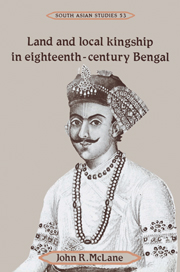Book contents
- Frontmatter
- Contents
- List of tables
- Preface and acknowledgments
- List of abbreviations
- Select glossary
- Map of southwest Bengal
- Part I Bengal
- Part II Burdwan
- 6 Mughal Burdwan and the rise of the Burdwan raj
- 7 Burdwan's expansion
- 8 The Maratha invasions, 1742-1751
- 9 Zamindars and the transition to Company rule
- 10 The famine of 1770
- 11 Revenue farming, 1771-1777
- 12 Zamindari family politics: the Burdwan raj, 1770-1775
- 13 The politics of Burdwan family debt and marriages, 1775-1778
- 14 Testing the limits, 1778–1790
- 15 Burdwan under the Decennial and Permanent Settlements
- 16 Patnis and the elusive quest for independence and security
- 17 Conclusion
- Bibliography
- Index
- Cambridge South Asian Studies
8 - The Maratha invasions, 1742-1751
from Part II - Burdwan
Published online by Cambridge University Press: 13 October 2009
- Frontmatter
- Contents
- List of tables
- Preface and acknowledgments
- List of abbreviations
- Select glossary
- Map of southwest Bengal
- Part I Bengal
- Part II Burdwan
- 6 Mughal Burdwan and the rise of the Burdwan raj
- 7 Burdwan's expansion
- 8 The Maratha invasions, 1742-1751
- 9 Zamindars and the transition to Company rule
- 10 The famine of 1770
- 11 Revenue farming, 1771-1777
- 12 Zamindari family politics: the Burdwan raj, 1770-1775
- 13 The politics of Burdwan family debt and marriages, 1775-1778
- 14 Testing the limits, 1778–1790
- 15 Burdwan under the Decennial and Permanent Settlements
- 16 Patnis and the elusive quest for independence and security
- 17 Conclusion
- Bibliography
- Index
- Cambridge South Asian Studies
Summary
Chitrasen's expansion was largely completed by April 1742 when the expanding Marathas invaded Bengal from central India for the first time. The Marathas returned annually until 1751, usually withdrawing before the summer monsoon turned the fields and roads to mud and made them almost impassable for the light Maratha cavalry. The Burdwan, Bishnupur, and Birbhum zamindaris and Midnapur district felt the brunt of these destructive incursions because of their proximity to the Maratha base in central India. In the long run, the invasions had no effect on the size of the Burdwan zamindari nor is there evidence that any members of the Burdwan raj family were killed. But the invasions caused immense hardship for the people of west Bengal. They also precipitated an economic crisis and diminished the legitimacy of the Murshidabad regime. They constitute a turning point in the history of the eighteenth century.
The invasions had their principal origin in the ambitions of Raghuji Bhonsla, the Maratha chief at Nagpur, to collect chauth or a share of the revenue in territories formerly under the Mughal empire. Yet the invasions might not have occurred but for the circumstances surrounding Alivardi Khan's usurpation of power from Nawab Sarfaraz in 1740. Sarfaraz, although a weak, debauched ruler, was the grandson of Murshid Quli Khan and the son of Shuja-ud-din (1727-39) and thus had legitimate claims to the masnad (throne). Alivardi, by contrast, came from a Turko-Arab family of modest social position and rose through the ranks of the Bengal government by the patronage of Sarfaraz's father.
- Type
- Chapter
- Information
- Land and Local Kingship in Eighteenth-Century Bengal , pp. 161 - 171Publisher: Cambridge University PressPrint publication year: 1993



